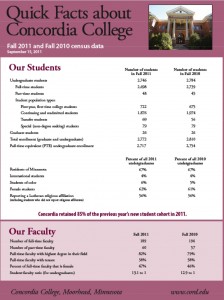
The Concordia College campus is full of more new faces than last year.
Scott Ellingson, director of enrollment, said enrollment numbers have improved in two major areas. The number of first-year students increased from 675 to 722 students. Additionally, the number of transfer students increased from 56 to 69 students.
Ellingson said the one of the greatest accomplishments Concordia College has made this year is in the area of retention. According to the college’s Sept. 15 census report, 85 percent of first-year students returned as sophomores this fall. The average has typically been between 79 and 82 percent. Ellingson said this year’s retention rate ranks the highest in at least 12 years.
While many factors contributed to an increase in new enrollment numbers, Ellingson noted that a new event called the Cobber Celebration may have played a role. The Enrollment Division hosted a special weekend for students who had been admitted to the college but did not get a chance to visit for a scholarship competition. The weekend included tours and faculty visits. Ellingson was pleased to see the amount of cooperation from the rest of campus for that event.
“People stepped up more than ever,” he said.
Last year’s incoming class was small compared to previous classes, so many people recognized that they needed to do more to keep prospective students interested in the college. The Cobber Celebration gave students a last look at Concordia before they made a final decision.
This progress shows in the number of students called the “melt.” The melt refers to prospective students who pay their housing deposit but decide not to enroll. This year, there were 22 fewer cancelled deposits than last year.
Recent changes in the administration, including a new president as well as a new vice president of enrollment, will reflect upon the enrollment division’s goals.
“To have that part of the team together helps us step forward,” Ellingson said.
Steve Schuetz, vice president for enrollment, said he would like to keep the number of incoming students at a level consistent with the current class. The current recession makes it difficult for a college to accommodate for more or less students.
“Every college wants to grow,” he said, “but with that comes some challenges.”
Incoming students are a changing demographic for most schools across the country. Schuetz said that, until 2009, the incoming student population in the upper Midwest had been increasingly white, middle class students who graduated from high schools in the Midwest. Since 2009, that population has been decreasing, and it will eventually level off in a few years.
When this occurs, more students from underrepresented racial and social groups will fill in the incoming classes.
Hence the need to “weather the storm” of the economic recession with a consistent population of students.
Schuetz said Concordia will adapt to a new composition of students, but now is not the time to make those adjustments.
The campus community can expect to see very similar numbers and quality of students in the near future.
